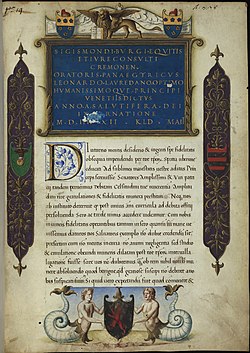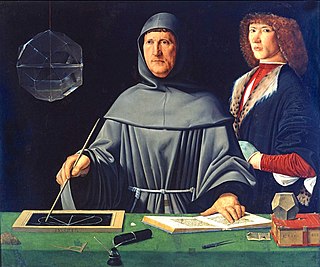
Fra Luca Bartolomeo de Pacioli was an Italian mathematician, Franciscan friar, collaborator with Leonardo da Vinci, and an early contributor to the field now known as accounting. He is referred to as "The Father of Accounting and Bookkeeping" in Europe and he was the first person to publish a work on the double-entry system of book-keeping on the continent. He was also called Luca di Borgo after his birthplace, Borgo Sansepolcro, Tuscany.

The Morgan Bible, also called the Morgan Picture Bible, Crusader Bible, Shah Abbas Bible or Maciejowski Bible, is a unique medieval illuminated manuscript. It is a picture book Bible consisting of 46 surviving folios. The book consists of miniature paintings of events from the Hebrew Bible, set in the scenery and costumes of thirteenth-century France, and depicted from a Christian perspective. It is not a complete Bible, as it consists largely of illustrations of stories of kings, especially King David. The illustrations are now surrounded by text in three scripts and five languages: Latin, Persian, Arabic, Judeo-Persian, and Hebrew. The level of detail in the images and the remarkable state of preservation of the work make it particularly valuable to scholars.

The Walters Art Museum, located in Mount Vernon-Belvedere, Baltimore, Maryland, United States, is a public art museum founded and opened in 1934. It holds collections established during the mid-19th century. The Museum's collection was amassed substantially by major American art and sculpture collectors, a father and son: William Thompson Walters, (1819–1894), who began collecting when he moved to Paris as a nominal Southern/Confederate sympathizer at the outbreak of the American Civil War in 1861; and Henry Walters (1848–1931), who refined the collection and made arrangements for the construction of a later landmark building to rehouse it. After allowing the Baltimore public to occasionally view his father's and his growing added collections at his West Mount Vernon Place townhouse/mansion during the late 1800s, he arranged for an elaborate stone palazzo-styled structure built for that purpose in 1905–1909. Located across the back alley, a block south of the Walters mansion on West Monument Street/Mount Vernon Place, on the northwest corner of North Charles Street at West Centre Street.

Codicology is the study of codices or manuscript books written on parchment as physical objects. It is often referred to as 'the archaeology of the book', concerning itself with the materials, as well as techniques used to make books, including their binding.

Leonardo Loredan was a Venetian nobleman and statesman who reigned as the 75th Doge of Venice from 1501 until his death in 1521. A wartime ruler, his dogeship was one of the most important in the history of Venice. In the dramatic events of the early 16th century, Loredan's Machiavellian plots and cunning political manoeuvres against the League of Cambrai, the Ottomans, the Mamluks, the Pope, the Republic of Genoa, the Holy Roman Empire, the French, the Egyptians and the Portuguese saved Venice from downfall.

Kufic script is a style of Arabic script that gained prominence early on as a preferred script for Quran transcription and architectural decoration, and it has since become a reference and an archetype for a number of other Arabic scripts. It developed from the Arabic alphabet in the city of Kufa, from which its name is derived. Kufic script is characterized by angular, rectilinear letterforms and its horizontal orientation. There are many different versions of Kufic script, such as square Kufic, floriated Kufic, knotted Kufic, and others.

Toros Roslin ; c. 1210–1270) was the most prominent Armenian manuscript illuminator in the High Middle Ages. Roslin introduced a wider range of narrative in his iconography based on his knowledge of western European art while continuing the conventions established by his predecessors. Roslin enriched Armenian manuscript painting by introducing new artistic themes such as the Incredulity of Thomas and Passage of the Red Sea. In addition he revived the genre of royal portraits, the first Cilician royal portraits having been found in his manuscripts. His style is characterized by a delicacy of color, classical treatment of figures and their garments, an elegance of line, and an innovative iconography.

The Portrait of Doge Leonardo Loredan is a painting by Italian Renaissance master Giovanni Bellini, dating from c. 1501–02. It portrays Leonardo Loredan, Doge of Venice from 1501 to 1521, in his ceremonial garments with the corno ducale worn over a linen cap, and is signed IOANNES BELLINVS on a cartellino. It is on display in the National Gallery in London.

Divina proportione, later also called De divina proportione is a book on mathematics written by Luca Pacioli and illustrated by Leonardo da Vinci, completed by February 9th, 1498 in Milan and first printed in 1509. Its subject was mathematical proportions and their applications to geometry, to visual art through perspective, and to architecture. The clarity of the written material and Leonardo's excellent diagrams helped the book to achieve an impact beyond mathematical circles, popularizing contemporary geometric concepts and images.

The House of Loredan is a Venetian noble family of supposed ancient Roman origin, which has played a significant role in shaping the history of the entire Mediterranean. A political dynasty, the family has throughout the centuries produced a number of famous personalities: doges, statesmen, magnates, procurators, providures, podestàs, military commanders, naval captains, church dignitaries, writers and lawyers.

Fatimid art refers to artifacts and architecture from the Fatimid Caliphate (909-1171), an empire based in Egypt and North Africa. The Fatimid Caliphate was initially established in the Maghreb, with its roots in a ninth-century Shia Ismailist Many monuments survive in the Fatimid cities founded in North Africa, starting with Mahdia, on the Tunisian coast, the principal city prior to the conquest of Egypt in 969 and the building of al-Qahira, the "City Victorious", now part of modern-day Cairo. The period was marked by a prosperity amongst the upper echelons, manifested in the creation of opulent and finely wrought objects in the decorative arts, including carved rock crystal, lustreware and other ceramics, wood and ivory carving, gold jewelry and other metalware, textiles, books and coinage. These items not only reflected personal wealth, but were used as gifts to curry favour abroad. The most precious and valuable objects were amassed in the caliphal palaces in al-Qahira. In the 1060s, following several years of drought during which the armies received no payment, the palaces were systematically looted. The libraries largely destroyed, precious gold objects melted down, with a few of the treasures dispersed across the medieval Christian world. Afterwards Fatimid artifacts continued to be made in the same style, but were adapted to a larger populace using less precious materials.
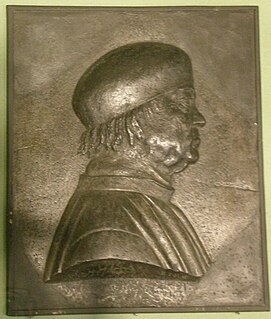
Tito Vespasiano Strozzi was an Italian Renaissance poet at the Este court of Ferrara, who figures as an interlocutor in Angelo Decembrio's De politia litteraria.
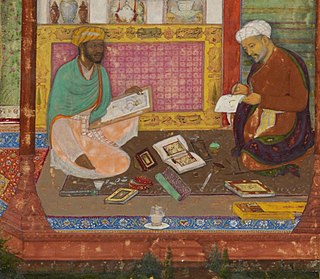
The illuminated manuscript Khamsa of Nizami British Library, Or. 12208 is a lavishly illustrated manuscript of the Khamsa or "five poems" of Nizami Ganjavi, a 12th-century Persian poet, which was created for the Mughal Emperor Akbar in the early 1590s by a number of artists and a single scribe working at the Mughal court, very probably in Akbar's new capital of Lahore in North India, now in Pakistan. Apart from the fine calligraphy of the Persian text, the manuscript is celebrated for over forty Mughal miniatures of the highest quality throughout the text; five of these are detached from the main manuscript and are in the Walters Art Museum, Baltimore as Walters Art Museum MS W.613. The manuscript has been described as "one of the finest examples of the Indo-Muslim arts of the book", and "one of the most perfect of the de luxe type of manuscripts made for Akbar".

The Howard Psalter and Hours is a 14th-century illuminated prayerbook. It includes a liturgical Psalter with canticles and litany, the Office of the Dead, a calendar of East Anglian origin and an incomplete Hours of the Passion. It was produced between 1310 and 1320. It is written in Latin in a Gothic script in two columns per page. There are 115 extant folios which measure 360 by 235 mm. The text block occupies an area of 250 by 166 mm. It is bound together with the De Lisle Psalter, a contemporary psalter.

The Madrid Codices I–II, are two manuscripts by Leonardo da Vinci which were discovered in the Biblioteca Nacional de España in Madrid in 1965 by Dr. Jules Piccus, Language Professor at the University of Massachusetts. The Madrid Codices I was finished during 1490 and 1499, and II from 1503 to 1505.
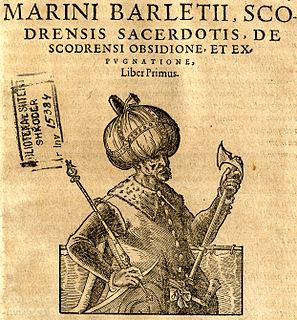
The Siege of Shkodra is a book written by a Shkodran priest, Marin Barleti, about the Ottoman siege of Shkodra in 1478, led personally by Mehmed II, and about the joint resistance of the Albanians and the Venetians. The book also discusses the Ottoman siege of Shkodra in 1474. The book was originally published in 1504, in Latin, as De obsidione Scodrensi. Barleti was an eyewitness of the events.

The Bruges Garter Book is a 15th-century illuminated manuscript containing portraits of the founder knights of the Order of the Garter. It was made to the order of William Bruges, Garter King of Arms, and constitutes the first armorial covering members of the Order. It has been held since 1883 by the British Library in London under catalogue reference Stowe MS 594, indicating its former existence within the Library of the Dukes of Buckingham at Stowe House.

The House of Loredan-Santo Stefano was a cadet branch of the House of Loredan that existed from the 14th century until 1767. The branch was mainly settled in the Palazzo Loredan in Campo Santo Stefano, which they acquired in 1536 from the Mocenigo family. The progenitor of the branch is considered to be Gerolamo Loredan "dal Barbaro" di S. Vitale (d.~1474), father of Doge Leonardo Loredan and Dogaressa Caterina Loredan. Besides Leonardo, the branch also gave Doge Francesco Loredan.
Loredan is a Venetian surname. The House of Loredan is an aristocratic Venetian family that included various doges of the Republic of Venice, and the surname is almost exclusively associated with the family. The surname most likely originated from the toponym Loreo, which itself originated from its Latin name Lauretum, meaning laurel. Another theory of the origin of the surname, though most likely legendary, is that it comes from the Latin epithet Laureati, given to ancestors of the Loredan family due to their historical glory in ancient Rome and the many victories they achieved in battles. The surname is spelled Loredano in Italian, Lauredano or Lauredanus in Latin, and Lorentano (Λορεντάνο) in Greek, though it is also historically found as Lordis (Λορδᾶς) and Lordano (Λορδάνο). The feminine name Loredana, common in Italy and Romania, was likely inspired by the surname.
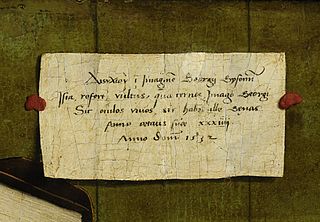
A cartellino is an illusionistic portrayal of a written note included in painting, mostly from the with a legend that records the name of the artist, the date, the subject, or some other relevant information about the work. About 500 Renaissance paintings include a cartellino, but the device has been adopted by some later artists.
